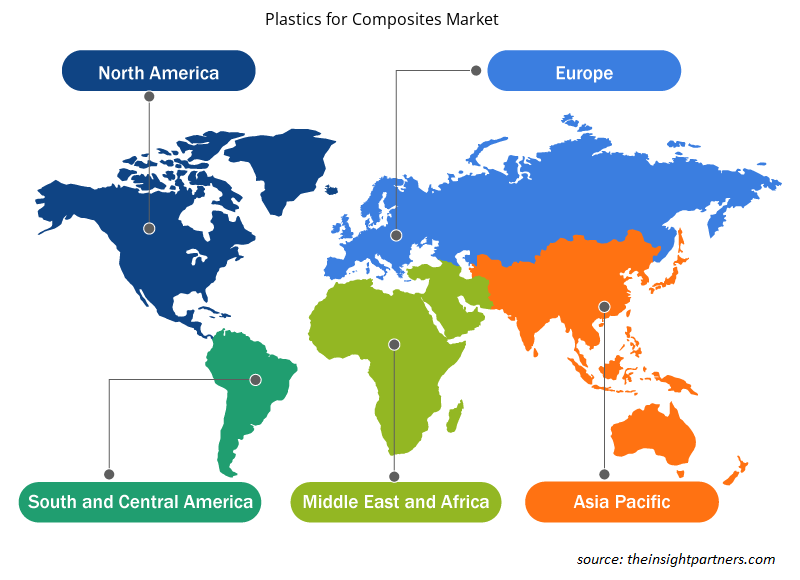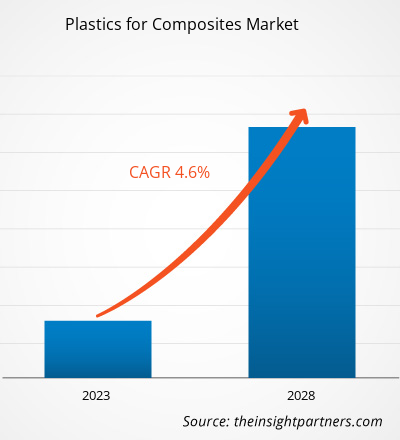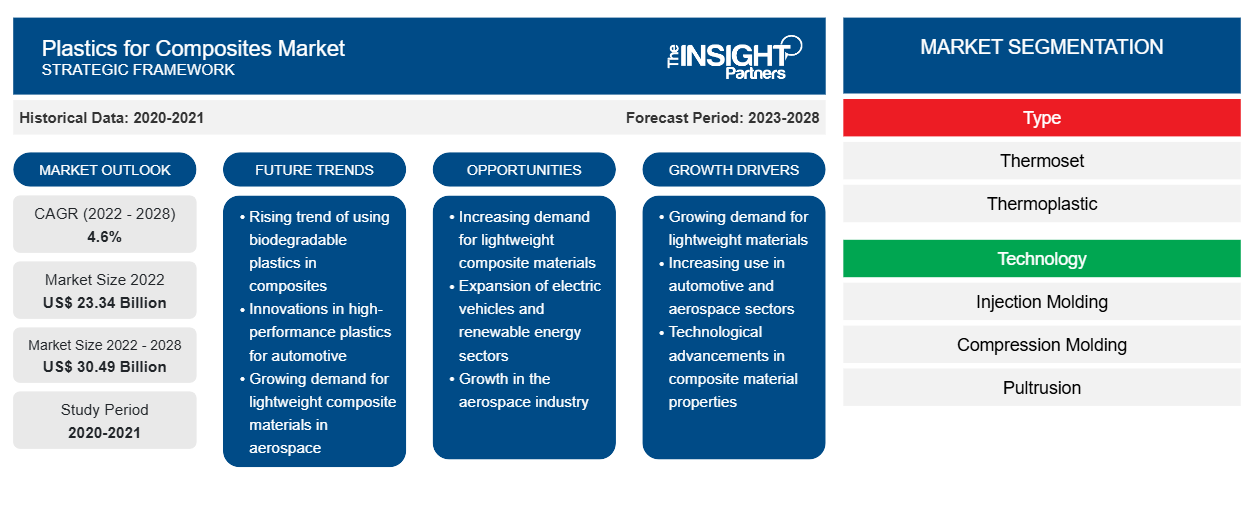Si prevede che il mercato delle materie plastiche per compositi crescerà da 23.337,24 milioni di dollari nel 2022 a 30.490,85 milioni di dollari entro il 2028; si stima che registrerà un CAGR del 4,6% dal 2022 al 2028.CAGR of 4.6% from 2022 to 2028.
I compositi sono materiali costituiti da due o più fasi chimicamente e fisicamente diverse, separate da un'interfaccia distinta. La maggior parte dei compositi prodotti commercialmente utilizza un materiale a matrice polimerica, spesso chiamato soluzione di resina. Le matrici polimeriche comunemente utilizzate includono poliestere, vinilestere, epossidico, fenolico, poliimmide, poliammide, polipropilene e polietere etere chetone (PEEK). Basso costo, facile lavorabilità, buona resistenza chimica e bassa gravità specifica sono tra i principali vantaggi associati alle matrici polimeriche.
La crescente adozione di resine composite nelle attività di edilizia e costruzione e nelle applicazioni aerospaziali e militari sta contribuendo alla crescita del mercato delle materie plastiche per compositi . Inoltre, la domanda di materiali leggeri nella produzione di veicoli, per migliorare l'efficienza del carburante, è un altro fattore che spinge l'espansione del mercato. Inoltre, la crescente domanda di resine termoplastiche sta contribuendo in modo significativo alla crescita complessiva del mercato delle materie plastiche per compositi. Fibre rigide e maggiore resistenza al calore, resistenza alle crepe, elevata resistenza agli urti e matrice polimerica resistente sono le principali caratteristiche dei compositi polimerici che ne determinano la popolarità. È probabile che i crescenti investimenti nella generazione di energia rinnovabile inneschino la domanda di compositi polimerici nei prossimi anni.
Personalizza questo report in base alle tue esigenze
Riceverai la personalizzazione gratuita di qualsiasi report, comprese parti di questo report, o analisi a livello nazionale, pacchetto dati Excel, oltre a usufruire di grandi offerte e sconti per start-up e università
-
Scopri le principali tendenze di mercato in questo rapporto.Questo campione GRATUITO includerà analisi di dati che spaziano dalle tendenze di mercato alle stime e alle previsioni.
Approfondimenti di mercato
La crescente domanda da parte dei settori automobilistico e aerospaziale stimola la crescita del mercato delle materie plastiche per compositi
La resina composita è utilizzata in varie applicazioni, tra cui edilizia e infrastrutture, trasporti, elettricità ed elettronica, energia eolica, condotte e serbatoi, marina, aerospaziale e militare. I materiali avanzati sono fondamentali per aumentare il risparmio di carburante delle automobili moderne, garantendo al contempo sicurezza e prestazioni. Poiché ci vuole meno energia per accelerare oggetti più leggeri rispetto a quelli più pesanti, i materiali leggeri offrono un potenziale eccellente per aumentare l'efficienza del veicolo. Pertanto, l'elevata domanda di compositi da parte dell'industria automobilistica per la produzione di veicoli leggeri ed efficienti nei consumi guida la crescita del mercato delle materie plastiche per compositi. Le industrie di utilizzo finale nelle economie emergenti, come Cina e India, sono i principali fattori che contribuiscono alla crescente domanda di materie plastiche per compositi. La crescente necessità di materiali più leggeri per costruire componenti e parti aeronautiche è stato un altro fattore significativo che ha contribuito alla crescita del mercato delle materie plastiche per compositi. I produttori di aeromobili stanno compiendo sforzi per ingrandire le strutture termoplastiche primarie nei jet aziendali e negli aerei commerciali. Sono stati i primi ad adottare termoplastiche rinforzate con fibre lunghe.
Tipo Informazioni
In base al tipo, il mercato delle materie plastiche per compositi è suddiviso in termoindurenti (poliestere, vinilestere, epossidico, poliuretano e altri) e termoplastici (polipropilene, polietilene, cloruro di polivinile, polistirene, polietilene tereftalato, policarbonato e altri). Il segmento dei termoindurenti ha detenuto una quota maggiore del mercato nel 2021. I termoindurenti sono un popolare materiale a matrice polimerica per compositi rinforzati con fibre. Esempi comuni di termoindurenti includono epossidici e poliesteri. Sono tra i principali tipi di sistemi a matrice, utilizzati specificamente nell'industria aerospaziale. I compositi a matrice termoindurente sono utilizzati più ampiamente rispetto ai compositi a matrice termoplastica a causa della loro minore viscosità a temperature relativamente basse (inferiori a 100 °C), che facilita meglio il processo di bagnatura resina/fibra. Si prevede che questi fattori guideranno la crescita del mercato dei componenti a matrice termoindurente.thermoset (polyester, vinyl ester, epoxy, polyurethane, and others) and thermoplastic (polypropylene, polyethylene, polyvinyl chloride, polystyrene, polyethylene terephthalate, polycarbonate, and others). The thermoset segment held a larger share of the market in 2021. Thermoset is a popular polymer matrix material for fiber-reinforced composites. Common examples of thermosets include epoxies and polyesters. They are among the major types of matrix systems, specifically used in the aerospace industry. Thermoset matrix composites are more extensively used than thermoplastic matrix composites due to their lower viscosity at relatively low temperatures (less than 100°C), which better facilitates the resin/fiber wetting process. These factors are expected to drive the growth of the market for thermoset matrix
Lanxess AG, Covestro AG, Celanese Corp, INEOS Group Holdings SA, Daicel Corp, BASF SE, Evonik Industries AG, Solvay SA, Saudi Basic Industries Corp e Arkema SA sono tra i principali attori che operano nel mercato delle materie plastiche per compositi. I principali attori adottano strategie come fusioni e acquisizioni e lanci di prodotti per espandere la loro presenza geografica e la base di consumatori. Ad esempio, a giugno 2022, Lanxess AG ha lanciato un composito con matrice in poliammide 6 basato su cicloesano "verde".
Approfondimenti regionali sul mercato delle materie plastiche per compositi
Le tendenze regionali e i fattori che influenzano il mercato delle materie plastiche per compositi durante il periodo di previsione sono stati ampiamente spiegati dagli analisti di Insight Partners. Questa sezione discute anche i segmenti e la geografia del mercato delle materie plastiche per compositi in Nord America, Europa, Asia Pacifico, Medio Oriente e Africa e America meridionale e centrale.

- Ottieni i dati specifici regionali per il mercato delle materie plastiche per compositi
Ambito del rapporto di mercato sulle materie plastiche per compositi
| Attributo del report | Dettagli |
|---|---|
| Dimensioni del mercato nel 2022 | 23,34 miliardi di dollari USA |
| Dimensioni del mercato entro il 2028 | 30,49 miliardi di dollari USA |
| CAGR globale (2022 - 2028) | 4,6% |
| Dati storici | 2020-2021 |
| Periodo di previsione | 2023-2028 |
| Segmenti coperti |
Per tipo
|
| Regioni e Paesi coperti |
America del Nord
|
| Leader di mercato e profili aziendali chiave |
|
Densità degli attori del mercato delle materie plastiche per compositi: comprendere il suo impatto sulle dinamiche aziendali
Il mercato delle materie plastiche per compositi sta crescendo rapidamente, spinto dalla crescente domanda degli utenti finali dovuta a fattori quali l'evoluzione delle preferenze dei consumatori, i progressi tecnologici e una maggiore consapevolezza dei vantaggi del prodotto. Con l'aumento della domanda, le aziende stanno ampliando le loro offerte, innovando per soddisfare le esigenze dei consumatori e capitalizzando sulle tendenze emergenti, il che alimenta ulteriormente la crescita del mercato.
La densità degli operatori di mercato si riferisce alla distribuzione di aziende o società che operano in un particolare mercato o settore. Indica quanti concorrenti (operatori di mercato) sono presenti in un dato spazio di mercato in relazione alle sue dimensioni o al valore di mercato totale.
Le principali aziende che operano nel mercato delle materie plastiche per compositi sono:
- Lanxess AG
- Covestro AG
- Celanese Corp
- Società del Gruppo INEOS SA
- Daicel Corp
Disclaimer : le aziende elencate sopra non sono classificate secondo un ordine particolare.

- Ottieni una panoramica dei principali attori del mercato delle materie plastiche per compositi
Segnala i riflettori
- Tendenze progressive nel settore delle materie plastiche per compositi per aiutare gli operatori a sviluppare strategie efficaci a lungo termine
- Strategie di crescita aziendale adottate dalle aziende per garantire la crescita nei mercati sviluppati e in via di sviluppo
- Analisi quantitativa del mercato globale delle materie plastiche per compositi dal 2020 al 2028
- Stima della domanda di materie plastiche per compositi in vari settori industriali
- Analisi delle cinque forze di Porter per illustrare l'efficacia degli acquirenti e dei fornitori che operano nel settore delle materie plastiche per i compositi
- Sviluppi recenti per comprendere lo scenario competitivo del mercato e la domanda di materie plastiche per compositi
- Tendenze e prospettive di mercato e fattori che regolano la crescita del mercato delle materie plastiche per compositi
- Strategie illuminanti che sostengono l'interesse commerciale in merito alla crescita del mercato, aiutando nel processo decisionale
- Dimensioni del mercato delle materie plastiche per compositi in vari nodi di mercato
- Panoramica dettagliata e segmentazione del mercato, nonché dinamiche del settore
- Dimensioni del mercato delle materie plastiche per compositi in varie regioni con promettenti opportunità di crescita
"Plastics for Composites Market Analysis to 2028" è uno studio specializzato e approfondito del settore chimico e dei materiali, incentrato sull'analisi delle tendenze del mercato delle plastiche per compositi. Il rapporto mira a fornire una panoramica del mercato con una segmentazione dettagliata. Il mercato delle plastiche per compositi è segmentato in base a tipo, tecnologia e geografia. In base al tipo, il mercato è segmentato in termoindurenti (poliestere, vinilestere, epossidico, poliuretano e altri) e termoplastici (polipropilene, polietilene, cloruro di polivinile, polistirene, polietilene tereftalato, policarbonato e altri). In base alla tecnologia, il mercato è segmentato in stampaggio a iniezione, stampaggio a compressione, pultrusione, infusione di resina e altri. In termini di geografia, il mercato è segmentato in cinque regioni principali: Nord America, Europa, Asia Pacifico, Medio Oriente e Africa e Sud e Centro America. Nel 2021, l'Asia Pacifico ha dominato il mercato delle plastiche per compositi. Si prevede che la regione registrerà il CAGR più elevato nel mercato durante il periodo di previsione. I settori automobilistico e delle costruzioni nell'Asia Pacifica stanno crescendo a un ritmo rapido. È la regione più popolata al mondo e ospita uno dei settori delle costruzioni in più rapido sviluppo al mondo. Questi fattori contribuiscono a un'elevata domanda di materie plastiche per compositi nell'Asia Pacifica.
- Analisi storica (2 anni), anno base, previsione (7 anni) con CAGR
- Analisi PEST e SWOT
- Valore/volume delle dimensioni del mercato - Globale, Regionale, Nazionale
- Industria e panorama competitivo
- Set di dati Excel
Report recenti
Rapporti correlati
Testimonianze
Motivo dell'acquisto
- Processo decisionale informato
- Comprensione delle dinamiche di mercato
- Analisi competitiva
- Analisi dei clienti
- Previsioni di mercato
- Mitigazione del rischio
- Pianificazione strategica
- Giustificazione degli investimenti
- Identificazione dei mercati emergenti
- Miglioramento delle strategie di marketing
- Aumento dell'efficienza operativa
- Allineamento alle tendenze normative























 Ottieni un campione gratuito per - Mercato delle materie plastiche per compositi
Ottieni un campione gratuito per - Mercato delle materie plastiche per compositi